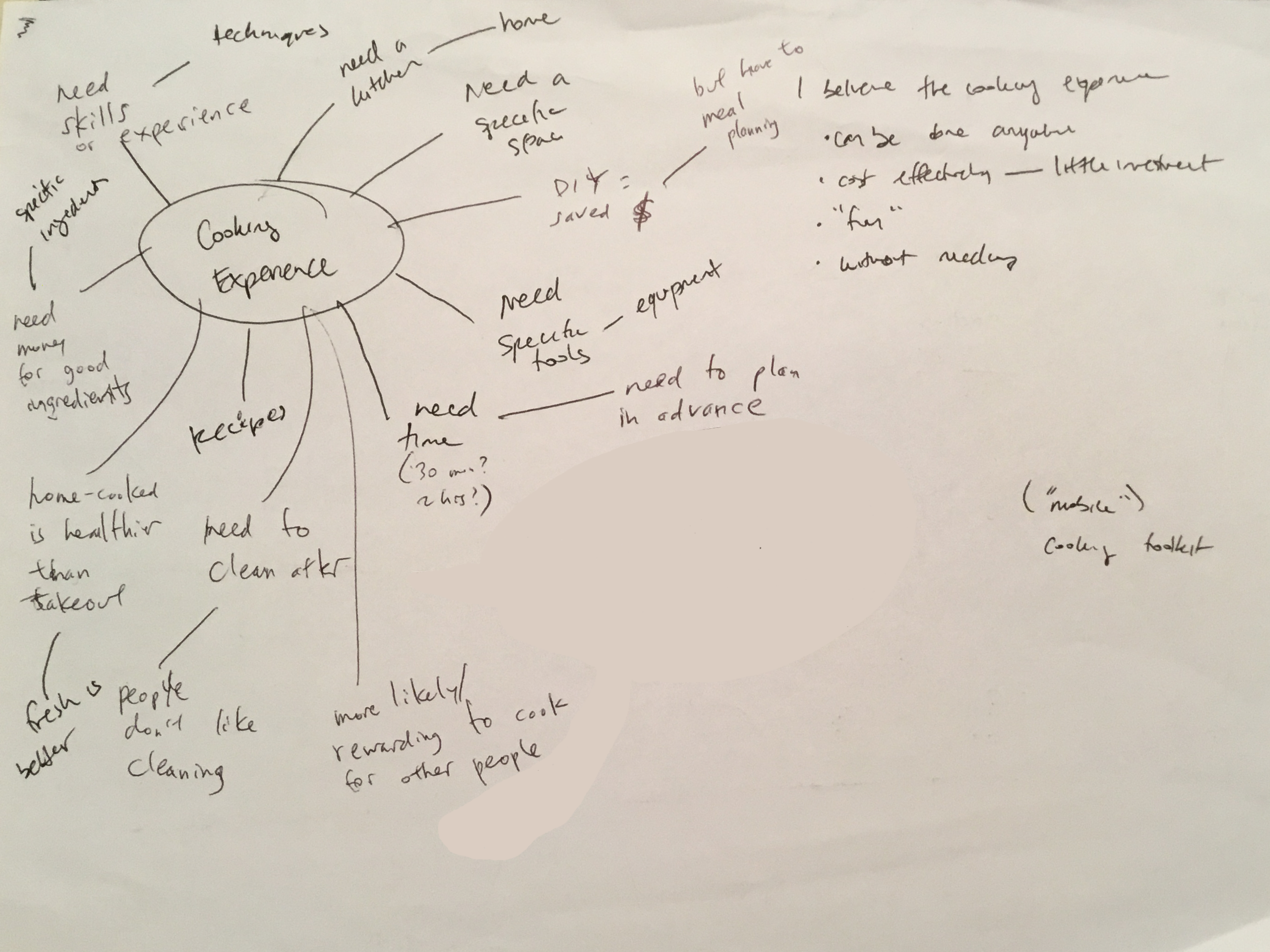Assumptions, Feedback and Thanksgiving
As the fall winds towards our final prototype of the semester, it’s worth looking back at a few ideas that have been locked up in my notes. A little ways back, we developed an assumption map—essentially, laying out the groundwork for our problem space so we can tackle it effectively. In the meantime, I also wanted to remind myself of some activities I’d performed personally that gave me more insight into potential user needs.
Assumption Mapping
As part of our fall’s work, one of our thesis class sessions revolved around the creation of an assumption map. A lot of good things came out of building an assumption map with my classmates, primarily the scope of the field I’m interested. Cooking is such a large, unwieldy field, it’ll be worth focusing more on a particular area or smaller set of user needs.
Assumptions
Although this assumption map exercise was done before my first prototype was finished, it didn’t necessarily contribute towards helping that project, since I was mostly in heads-down working mode.

Some basic assumptions about cooking:
- Requirements for having good or specific tools
- Space that is specific to the work being done
- Time for all the various activities
- Knowledge of recipes, techniques
- Desire (or lack thereof) for cleaning
Though the exercise was quick, the results behind it were interesting and important, and the kind of work I would like to return to later.
Class Feedback
While I would still like to make an effort to survey potential users about what keeps them from cooking, particularly to validate some of these assumptions, I also spent a little time talking with my class about what they see as habits or potential pitfalls.
The discussion ended up depicting the cooking experience as this sort of roller coaster of emotional state, which ended in mediocre outcomes: either dropping off, or feeling uninspired. As one person said, “I did all the things you’re supposed to do,” but the difficulty of trying to know how much effort is required to get to the next step or produce a new dish is difficult to know, and doesn’t overcome a perceived lack of excitement for an activity that’s no longer novel. How, the question went, do you get to get people to continue?
From a testing scenario for the final prototype, there were important questions that needed to be answered in its design, all centered around how this would be different than the last prototype and what, exactly, was being tested. It needed to be clear what I was planning to test so that the results are meaningful.
Competitive Testing
In my personal life, I was trying out some of the competitive landscape around cooking and specifically meal delivery services. Late in the spring, I signed up for Blue Apron, mostly for the practicality (or convenience) of directly-delivered fresh groceries at a size just large enough for me to make meals for myself with some leftovers, or to share with a significant other.
Early this fall, I signed up for Hello Fresh at the suggestion of a friend, which I tried for a few weeks as a comparison. Hello Fresh is a more nicely presented package of individual meals, with all the pieces together, it felt a little more wasteful than Blue Apron, which has made significant efforts at efficiency with smaller boxes and smarter packaging.
I also got turned onto an article about meal prep subscription boxes, trying to look at their cost-effectiveness against each other. It brought a bunch more competitors to light for me, which provided a better lay of the land.
Ultimately, the meal-subscription ground is well-trod, and the kind of logistical trouble that seems not worth my brainpower. Gives me great memories of 99% Invisible’s episodes on MREs and shipping containers.
Cooking with Family
Over the Thanksgiving break, I ended up cooking far more than usual as a part of testing out the various physical spaces of family members, along with their equipment.
One mistake I made in retrospect was not involving my family enough in the process. Most of the time, it was fairly solo work, but instead of seeing how they would cope with new ingredients or how they have accommodated themselves to their space, I took control of the situation to try to see how it would go.
Despite that, it wasn’t a completely one-person operation. At my parents’ house, at least, I managed to involve my mother in the project to help speed things up. What I noticed from that interaction was about being able to centralize preparatory space—because of some of the fixed equipment in the kitchen, my mother had to work in the dining room in order to get some thing ready, which in retrospect was kind of crazy.
The other obvious problem I encountered was around tools. It’s unclear to me how this happens, but in all three places I cooked—my aunt’s, my grandmother’s and my parents’—nobody had a decent knife. Surfaces on which to cut were also difficult to come by in most cases. I still can’t put my finger on it but something is missing.
Looking Ahead
What feels important coming up will be a physical manifestation of my thesis so far. It feels like it’s leaking out of my brain. The assumption map was a start, but it needs a bigger output.